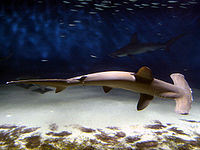Pelagic fish
Pelagic fish live in the
The marine pelagic environment is the largest aquatic habitat on Earth, occupying 1,370 million cubic kilometres (330 million cubic miles), and is the habitat for 11% of known fish species. The oceans have a mean depth of 4,000 metres (2.5 miles). About 98% of the total water volume is below 100 metres (330 ft), and 75% is below 1,000 metres (3,300 ft).[2]
Marine pelagic fish can be divided into coastal (inshore) fish and oceanic (offshore) fish. Coastal pelagic fish inhabit the relatively shallow and sunlit waters above the continental shelf, while oceanic pelagic fish inhabit the vast and deep waters beyond the continental shelf (even though they also may swim inshore).[3][4]
Pelagic fish range in size from small coastal
Epipelagic fish
Epipelagic fish inhabit the
A vast habitat for most pelagic fish, the epipelagic zone is well lit so visual predators can use their eyesight, is usually well mixed and
Epipelagic fish can be divided broadly into small

Most epipelagic predator fish and their smaller prey fish are countershaded with silvery colours that reduce visibility by scattering incoming light.[6] The silvering is achieved with reflective fish scales that function as small mirrors. This may give an effect of transparency. At medium depths at sea, light comes from above, so a mirror that is oriented vertically makes animals such as fish invisible from the side.[7]
In the shallower epipelagic waters, the mirrors must reflect a mixture of wavelengths, and the fish accordingly, has crystal stacks with a range of different spacings. A further complication for fish with bodies that are rounded in cross-section is that the mirrors would be ineffective if laid flat on the skin, as they would fail to reflect horizontally. The overall mirror effect is achieved with many small reflectors, all oriented vertically.[7]
Although the number of species is limited, epipelagic fishes are abundant. What they lack in diversity they make up for in numbers. Forage fish occur in huge numbers, and large fish that prey on them often are sought after as premier
Many forage fish are facultative predators that can pick individual copepods or fish larvae out of the water column, and then change to filter feeding on phytoplankton when that gives better results energetically. Filter feeding fish usually use long fine gill rakers to strain small organisms from the water column. Some of the largest epipelagic fishes, such as the basking shark and whale shark, are filter feeders, and so are some of the smallest, such as adult sprats and anchovies.[8]
Ocean waters that are exceptionally clear contain little food. Areas of high productivity tend to be somewhat turbid from
Floating objects
Epipelagic fish are fascinated by floating objects. They aggregate in considerable numbers around objects such as drifting flotsam, rafts, jellyfish, and floating seaweed. The objects appear to provide a "visual stimulus in an optical void".[10] Floating objects may offer refuge for juvenile fish from predators. An abundance of drifting seaweed or jellyfish can result in significant increases in the survival rates of some juvenile species.[11]
Many coastal juveniles use seaweed for the shelter and the food that is available from invertebrates and other fish associated with it. Drifting seaweed, particularly the pelagic Sargassum, provide a niche habitat with its own shelter and food, and even supports its own unique fauna, such as the sargassum fish.[8] One study, off Florida, found 54 species from 23 families living in flotsam from Sargassum mats.[12] Jellyfish also are used by juvenile fish for shelter and food, even though jellyfish can prey on small fish.[13]
Mobile oceanic species such as
A study using
Larger fish, even predator fish such as the
Coastal fish

Coastal epipelagic fish are among the most abundant in the world. They include forage fish as well as the predator fish that feed on them. Forage fish thrive in those inshore waters where high productivity results from the upwelling and shoreline run off of nutrients. Some are partial residents that spawn in streams, estuaries, and bays, but most complete their life cycle in the zone.[8]
Oceanic fish

Oceanic fish (also called open ocean or offshore fish) live in the waters that are not above the continental shelf. Oceanic fish can be contrasted with coastal fish, who do live above the continental shelf. However, the two types are not mutually exclusive, since there are no firm boundaries between coastal and ocean regions, and many epipelagic fish move between coastal and oceanic waters, particularly in different stages in their life cycle.[8]
Oceanic epipelagic fish can be true residents, partial residents, or accidental residents. True residents live their entire life in the open ocean. Only a few species are true residents, such as
Partial residents occur in three groups: species that live in the zone only when they are juveniles (drifting with jellyfish and seaweeds); species that live in the zone only when they are adults (salmon, flying fish, dolphin, and whale sharks); and deep water species that make nightly migrations up into the surface waters (such as the lanternfish).[8] Accidental residents occur occasionally when adults and juveniles of species from other environments are carried accidentally into the zone by currents.[8]
-
The huge ocean sunfish, a true resident of the ocean epipelagic zone, sometimes drifts with the current, eating jellyfish.
-
The giant whale shark, another resident of the ocean epipelagic zone, filter feeds on plankton, and periodically dives deep into the mesopelagic zone.
-
Lanternfish are partial residents of the ocean epipelagic zone During the day they hide in deep waters, but at night they migrate up to surface waters to feed.
Deep water fish
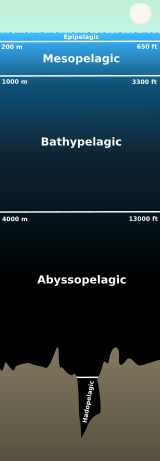
In the deep ocean, the waters extend far below the epipelagic zone and support very different types of pelagic fishes adapted to living in these deeper zones.[2]
In deep water,
Some deep-sea pelagic groups, such as the
The fish in the different pelagic and deep water benthic zones are physically structured, and behave, in ways that differ markedly from each other. Groups of coexisting species within each zone all seem to operate in similar ways, such as the small mesopelagic
Ray finned species, with spiny fins, are rare among deep sea fishes, which suggests that deep sea fish are ancient and so well adapted to their environment that invasions by more modern fishes have been unsuccessful.[18] The few ray fins that do exist are mainly in the Beryciformes and Lampriformes, which also are ancient forms. Most deep sea pelagic fishes belong to their own orders, suggesting a long evolution in deep sea environments. In contrast, deep water benthic species are in orders that include many related shallow water fishes.[19]
Many species move daily between zones in vertical migrations. In the following table, they are listed in the middle or deeper zone where they regularly are found.
| Zone | Species and species groups include: |
|---|---|
| Epipelagic[6] |
|
| Mesopelagic | |
| Bathypelagic | Principally flabby whalefish .
|
| Benthopelagic[6] | brotula are particularly abundant.
|
| Benthic |
| Epipelagic | Mesopelagic | Bathypelagic | Deep sea benthic
| |
|---|---|---|---|---|
| muscles | muscular bodies | poorly developed, flabby | ||
| skeleton | strong, ossified bones | weak, minimal ossification | ||
| scales | yes | none | ||
| nervous systems | well developed | lateral line and olfactory only | ||
| eyes | large and sensitive | small and may not function | variable (well developed to absent) | |
| photophores | absent | common | common | usually absent |
| gills | well developed | |||
| kidneys | large | small | ||
| heart | large | small | ||
| swimbladder | vertically migratory fish have swimbladders | reduced or absent | variable (well developed to absent) | |
| size | usually under 25 cm | variable, species greater than one metre are not uncommon |
Mesopelagic fish


Below the epipelagic zone, conditions change rapidly. Between 200 metres and approximately 1000 metres, light continues to fade until darkness is nearly complete. Temperatures fall through a
Sonar operators, using the sonar technology developed during World War II, were puzzled by what appeared to be a false sea floor 300–500 metres deep at day, and less deep at night. This turned out to be due to millions of marine organisms, most particularly small mesopelagic fish, with swimbladders that reflected the sonar.
Mesopelagic organisms migrate into shallower water at dusk to feed on plankton. The layer is deeper when the moon is out, and may move higher when the sky is dark. This phenomenon has come to be known as the deep scattering layer.[22]
Most mesopelagic fish make daily vertical migrations, moving each night into the epipelagic zone, often following similar migrations of zooplankton, and returning to the depths for safety during the day.[21][2][23] These vertical migrations occur over hundreds of meters.
These fish have muscular bodies, ossified bones, scales, well developed gills and central nervous systems, and large hearts and kidneys. Mesopelagic plankton feeders have small mouths with fine gill rakers, while the piscivores have larger mouths and coarser gill rakers.[21][2]
Vertically migratory fish have
Mesopelagic fish are adapted for an active life under low light conditions. Most of them are visual predators with large eyes. Some of the deeper water fish such as the Telescopefish have tubular eyes with big lenses and only rod cells that look upward. These give binocular vision and great sensitivity to small light signals.[2] This adaptation gives improved terminal vision at the expense of lateral vision, and allows the predator to pick out squid, cuttlefish, and smaller fish that are silhouetted above them.[21]
Mesopelagic fish usually lack defensive spines, and use colour for camouflage.[21] Ambush predators are dark, black or red. Since the longer, red, wavelengths of light do not reach the deep sea, red effectively functions the same as black. Migratory forms use countershaded silvery colours. On their bellies, they often display photophores producing low grade light. For a predator from below, looking upward, this bioluminescence camouflages the silhouette of the fish. However, some of these predators have yellow lenses that filter the (red deficient) ambient light, leaving the bioluminescence visible.[26]
-
The Antarctic toothfish have large, upward looking eyes, adapted to detecting the silhouettes of prey fish.[27]
-
The stoplight loosejaw is also one of the few fishes that produce red bioluminescence. As most of their prey cannot perceive red light, this allows it to hunt with an essentially invisible beam of light.[29]
The brownsnout spookfish is a species of barreleye and is the only vertebrate known to employ a mirror, as opposed to a lens, to focus an image in its eyes.[31][32]
Sampling via deep trawling indicates that lanternfish account for as much as 65% of all deep sea fish biomass.[33] Indeed, lanternfish are among the most widely distributed, populous, and diverse of all vertebrates, playing an important ecological role as prey for larger organisms. The estimated global biomass of lanternfish is 550–660 million tonnes, several times the entire world fisheries catch. Lanternfish also account for much of the biomass responsible for the deep scattering layer of the world's oceans. Sonar reflects off the millions of lanternfish swim bladders, giving the appearance of a false bottom.[34]
The 2010 Malaspina Circumnavigation Expedition traveled 60,000 km, undertaking acoustic observations. It reported that mesopelagic biomass was 10 billion tonnes or more (10x prior estimates), comprising about 90 percent of all ocean fish biomass.[35] Estimates of how much carbon these fish sequester remained highly uncertain as of 2024.[36]
Mesopelagic fish do not constitute a major fishery as of 2024. Initial efforts in Iceland, Norway, and the Soviet Union did not create a commercial industry. The European Union funded the MEESO project to study abundance and fishing technologies for key mesopelagic species. To date, fish that appeal to the human palate have not been identified, leading harvesters to focus on animal feed markets instead.[36]
Bigeye tuna are an epipelagic/mesopelagic species that is carnivorous, eating other fish. Satellite tagging has shown that bigeye tuna often spend prolonged periods cruising deep below the surface during the daytime, sometimes making dives as deep as 500 metres (1,600 feet). These movements are thought to be in response to the vertical migrations of prey organisms in the deep scattering layer.
-
Longnose lancetfish. Lancetfish are ambush predators that frequent the mesopelagic. They are among the largest mesopelagic fishes (up to 2 metres).[37]
-
The telescopefish has large, forward-pointing telescoping eyes with large lenses.[38]
-
Thedaggertooth slashes other mesopelagic fish when it bites them with its dagger-like teeth.[39]
-
Bigeye tuna cruise the epipelagic zone at night and the mesopelagic zone during the day.
-
A collection of mesopelagic forage fishes trawled from the Gulf of Mexico that includesbristlemouths, and a barracudina
Bathypelagic fish

Below the mesopelagic zone it is pitch dark. This is the midnight or
Conditions are somewhat uniform throughout these zones, the darkness is complete, the pressure is crushing, and temperatures, nutrients, and dissolved oxygen levels are all low.[2]
Bathypelagic fish have special adaptations to cope with these conditions – they have slow metabolisms and unspecialized diets, being willing to eat anything that comes along. They prefer to sit and wait for food rather than waste energy searching for it. The behaviour of bathypelagic fish can be contrasted with the behaviour of mesopelagic fish. Mesopelagic are often highly mobile, whereas bathypelagic fish are almost all lie-in-wait predators, normally expending little energy in movement.[44]
The dominant bathypelagic fishes are small
Bathypelagic fish are sedentary, adapted to outputting minimum energy in a habitat with very little food or available energy, not even sunlight, only bioluminescence. Their bodies are
These are the same features found in fish
Despite their ferocious appearance, these beasts of the deep are mostly miniature fish with weak muscles, and are too small to represent any threat to humans.
The swimbladders of deep sea fish are either absent or scarcely operational, and bathypelagic fish do not normally undertake vertical migrations. Filling bladders at such great pressures incurs huge energy costs. Some deep sea fishes have swimbladders that function while they are young and inhabit the upper epipelagic zone, but they wither or fill with fat when the fish move down to their adult habitat.[47]
The most important sensory systems are usually the
It is not easy finding a mate in this zone. Some species depend on
Many animal forms other than fish live in the bathypelagic zone, such as squid, large whales, octopuses, sponges,
-
The gulper eel uses its mouth like a net by opening its large mouth and swimming at its prey. It has a luminescent organ at the tip of its tail to attract prey.
-
Femalegonads, for use when the female is ready to spawn.
-
The Sloane's viperfish can make nightly migrations from bathypelagic depths to near surface waters.[53]
Demersal fish
In deep waters, the fishes of the demersal zone are active and relatively abundant, compared to fishes of the bathypelagic zone.[44]
The bodies of deep water
Deep sea benthic fish are usually long and narrow. Many are eels or shaped like eels. This may be because long bodies have long lateral lines. Lateral lines detect low-frequency sounds, and some benthic fishes appear to have muscles that drum such sounds to attract mates.[18] Smell is also important, as indicated by the rapidity with which benthic fish find traps baited with bait fish.
The main diet of deep sea benthic fish is invertebrates of the deep sea benthos and carrion. Smell, touch, and lateral line sensitivities seem to be the main sensory devices for locating these.[55]
Deep sea benthic fish can be divided into strictly benthic fish and benthopelagic fish. Usually, strictly benthic fish are negatively buoyant, while benthopelagic fish are neutrally buoyant. Strictly benthic fish stay in constant contact with the bottom. They either lie in wait as ambush predators or move actively over the bottom in search for food.[55]


Benthopelagic fish
Benthopelagic fish inhabit the water just above the bottom, feeding on benthos and benthopelagic zooplankton.[56] Most dermersal fish are benthopelagic.[54]
They can be divided into flabby or robust body types. Flabby benthopelagic fishes are like bathopelagic fishes, they have a reduced body mass, and low metabolic rates, expending minimal energy as they lie and wait to
Robust benthopelagic fish are muscular swimmers that actively cruise the bottom searching for prey. They may live around features, such as seamounts, which have strong currents.[59] Examples are the orange roughy and Patagonian toothfish. Because these fish were once abundant, and because their robust bodies are good to eat, these fish have been harvested commercially.[60][61]
Benthic fish
Benthic fish are not pelagic fish, but they are discussed here briefly, by way of completeness and contrast.
Some fishes do not fit into the above classification. For example, the family of nearly blind
The deepest-living fish known, the strictly benthic Abyssobrotula galatheae, eel-like and blind, feeds on benthic invertebrates.[63][64]
-
Pacific hagfish resting on bottom. Hagfish coat themselves and any dead fish they find with noxious slime, making them inedible to other species.
-
The tripodfish (Bathypterois grallator), a species of spiderfish, uses its fin extensions to "stand" on the bottom.[65]
-
Theblotched fantail ray feeds on bottom-dwelling fish, bivalves, crabs, and shrimps.[66]
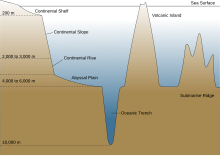
At great depths, food scarcity and extreme pressure works to limit the survivability of fish. The deepest point of the ocean is about 11,000 metres (6.8 miles). Bathypelagic fishes are not normally found below 3,000 metres (1.9 miles). The greatest depth recorded for a benthic fish is 8,370 m (5.20 mi).[67] It may be that extreme pressures interfere with essential enzyme functions.[40]
Benthic fishes are more diverse and are likely to be found on the
Pelagic fisheries
Forage fish
Major marine wild fisheries
|
Small pelagic fish are usually forage fish that are hunted by larger pelagic fish and other predators. Forage fish filter feed on plankton and are usually less than 10 centimetres (3.9 inches) long. They often stay together in schools and may migrate large distances between spawning grounds and feeding grounds. They are found particularly in upwelling regions around the northeast Atlantic, off the coast of Japan, and off the west coasts of Africa and the Americas. Forage fish are generally short-lived, and their stocks fluctuate markedly over the years.[68]
Traditional fisheries for anchovies and sardines also have operated in the Pacific, the Mediterranean, and the southeast Atlantic.[72] The world annual catch of forage fish in recent years has been approximately 22 million tonnes, or one quarter of the world's total catch.
-
ThesePacific sardines are forage fish.
-
Peruvian anchoveta
Predator fish
Medium size pelagic fishes include
Around Europe there are three populations of coastal mackerel. One population migrates to the North Sea, another stays in the waters of the Irish Sea, and the third population migrates southward along the west coast of Scotland and Ireland. The cruise speed of the mackerel is an impressive 10 kilometres per hour.[69][74]
Many large pelagic fish are oceanic nomadic species that undertake long offshore migrations. They feed on small pelagic forage fish, as well as medium-sized pelagic fish. At times, they follow their schooling prey, and many species form schools themselves.
Examples of larger pelagic fish are
Tuna in particular are of major importance to commercial fisheries. Although tuna migrate across oceans, trying to find them there is not the usual approach. Tuna tend to congregate in areas where food is abundant, along the boundaries of currents, around islands, near seamounts, and in some areas of upwelling along continental slopes. Tuna are captured by several methods:
Other large pelagic fish are premier game fish, particularly marlin and swordfish.
-
Yellowfin tuna are being fished as a replacement for the now largely depleted Southern bluefin tuna.

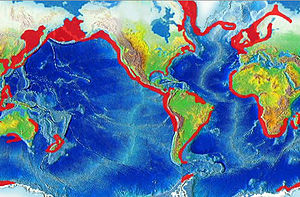
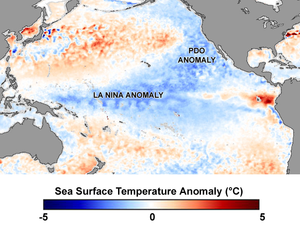
Productivity
Upwelling occurs both along coastlines and in midocean when a collision of deep ocean currents brings cold water that is rich in nutrients to the surface. These upwellings support blooms of phytoplankton, which in turn, produce zooplankton and support many of the world's main fisheries. If the upwelling fails, then fisheries in the area fail.[14]
In the 1960s the
Off Japan, the collision of the Oyashio Current with the Kuroshio Current produces nutrient-rich upwellings. Cyclic changes in these currents resulted in a decline in the sardine sardinops melanosticta populations. Fisheries catches fell from 5 million tonnes in 1988 to 280 thousand tonnes in 1998. As a further consequence, Pacific bluefin tuna stopped moving into the region to feed.[76][77]
Ocean currents can shape how fish are distributed, both concentrating and dispersing them. Adjacent ocean currents can define distinct, if shifting, boundaries. These boundaries can even be visible, but usually their presence is marked by rapid changes in salinity, temperature, and turbidity.[14]
For example, in the Asian northern Pacific, albacore are confined between two current systems. The northern boundary is determined by the cold North Pacific Current and the southern boundary is determined by the North Equatorial Current. To complicate things, their distribution is further modified within the area defined by the two current systems by another current, the Kuroshio Current, whose flows fluctuate seasonally.[78]
Epipelagic fish often spawn in an area where the eggs and larvae drift downstream into suitable feeding areas, and eventually, drift into adult feeding areas.[14]
Islands and
- Scombrids
Highly migratory species

Epipelagic fish generally move long distances between feeding and spawning areas, or as a response to changes in the ocean. Large ocean predators, such as salmon and tuna, can migrate thousands of kilometres, crossing oceans.[81]
In a 2001 study, the movements of Atlantic bluefin tuna from an area off North Carolina were studied with the help of special popup tags. When attached to a tuna, these tags monitored the movements of the tuna for about a year, then detached and floated to the surface where they transmitted their information to a satellite. The study found that the tuna had four different migration patterns. One group confined itself to the western Atlantic for a year. Another group also stayed mainly in the western Atlantic, but migrated to the Gulf of Mexico for spawning. A third group moved across the Atlantic Ocean and back again. The fourth group crossed to the eastern Atlantic and then moved into the Mediterranean Sea for spawning. The study indicates that, while there is some differentiation by spawning areas, there is essentially only one population of Atlantic bluefin tuna, intermixing groups that between them, use all of the north Atlantic Ocean, the Gulf of Mexico, and the Mediterranean Sea.[82]
The term
The highly migratory species include:
Essentially, highly migratory species coincide with the larger of the "large pelagic fish", discussed in the previous section, if cetaceans are added and some commercially unimportant fish, such as the
Capture production
According to the
| Capture production by groups of species in tonnes | ||||||||
|---|---|---|---|---|---|---|---|---|
| Type | Group | 1999 | 2000 | 2001 | 2002 | 2003 | 2004 | 2005 |
| Small pelagic fish | Herrings, sardines, anchovies | 22 671 427 | 24 919 239 | 20 640 734 | 22 289 332 | 18 840 389 | 23 047 541 | 22 404 769 |
| Large pelagic fish | Tunas, bonitos, billfishes | 5 943 593 | 5 816 647 | 5 782 841 | 6 138 999 | 6 197 087 | 6 160 868 | 6 243 122 |
| Other pelagic fish | 10 712 994 | 10 654 041 | 12 332 170 | 11 772 320 | 11 525 390 | 11 181 871 | 11 179 641 | |
Cartilaginous fish
|
Sharks, rays, chimaeras | 858 007 | 870 455 | 845 854 | 845 820 | 880 785 | 819 012 | 771 105 |
Threatened species
In 2009, the International Union for Conservation of Nature (IUCN) produced the first red list for threatened oceanic sharks and rays. They claim that approximately one third of open ocean sharks and rays are under threat of extinction.[87] There are 64 species of oceanic sharks and rays on the list, including hammerheads, giant devil rays, and porbeagle.[88]
Oceanic sharks are
The northwest Atlantic Ocean shark populations are estimated to have declined by 50% since the early 1970s. Oceanic sharks are vulnerable because they do not produce many young, and the young can take decades to mature.[88]
-
The scalloped hammerhead is classified as endangered.
-
The devil fish, a large ray, is threatened.
-
The porbeagle shark is threatened.
In parts of the world the scalloped hammerhead shark has declined by 99% since the late 1970s. Its status on the red list is that it is globally endangered, meaning it is near extinction.[88]
See also
References
Notes
- ^ ISBN 978-0-8248-2265-1.
- ^ a b c d e f g h Moyle and Cech, p. 585
- ^ McLintock, A H (ed.) (1966) "Pelagic". Te Ara – The Encyclopaedia of New Zealand. Accessed: 29 Sep 2022.
- ^ Walrond, Carl. "Oceanic fish". Encyclopedia of New Zealand. Accessed: 29 Sep 2022
- ^ "Lake Tanganyika". pcwww.liv.ac.uk.
- ^ a b c d e f g Moyle and Cech, p. 571
- ^ ISBN 978-0-19-854956-7.
- ^ a b c d e f g Moyle and Cech, p. 572
- ^ Blackburn (1965). "Oceanography and the ecology of tunas". Oceanography and Marine Biology: An Annual Review. 3: 299–322.
- ^ Hunter, JR; Mitchell CT (1966). "Association of fishes with flotsam in the offshore waters of Central America". Fishery Bulletin. 66: 13–29.
- ^ Kingsford MJ (1993). "Biotic and abiotic structure in the pelagic environment: Importance to small fishes". Bulletin of Marine Science. 53 (2): 393–415.
- ^ Dooley JK (1972). "Fishes associated with the pelagic sargassum complex, with a discussion of the sargassum community". Contributions in Marine Science. 16: 1–32.
- ^ Moyle and Cech, p. 576
- ^ a b c d e Moyle and Cech, pp. 574–575
- .
- S2CID 23551149.
- ^ a b Moyle and Cech, p. 591
- ^ .
- ^ Moyle and Cech, p. 586
- ^ Froese, Rainer; Pauly, Daniel (eds.) (2009). "Argyropelecus aculeatus" in FishBase. August 2009 version.
- ^ a b c d e Salvanes, A.G.V.; Kristoffersen, J.B. (2001). "Mesopelagic Fishes" (PDF). Encyclopedia of Ocean Sciences. 3. Retrieved 4 November 2020.
- ^ a b Ryan P "Deep-sea creatures: The mesopelagic zone" Te Ara – the Encyclopedia of New Zealand. Updated 21 September 2007.
- ^ Bone and Moore, p. 38.
- PMID 1251208.
- ^ Moyle and Cech, p. 590
- S2CID 86353657.
- ^ Froese, Rainer; Pauly, Daniel (eds.) (2009). "Dissostichus mawsoni" in FishBase. August 2009 version.
- ^ Mystery Of Deep-sea Fish With Tubular Eyes And Transparent Head Solved ScienceDaily, 24 February 2009.
- ^ S2CID 1038874.
- .
- S2CID 18680315.)
{{cite journal}}: CS1 maint: multiple names: authors list (link - ^ Smith, L. (8 January 2009). "Fish with four eyes can see through the deep sea gloom". Times Online. Times Newspapers Ltd. Retrieved 14 March 2009.
- ISBN 978-0-12-547665-2.
- ^ Cornejo, R.; Koppelmann, R. & Sutton, T. (2006). "Deep-sea fish diversity and ecology in the benthic boundary layer".
- ISSN 1539-607X.
- ^ a b Donovan, Moira (21 November 2023). "All the Fish We Cannot See". Hakai Magazine. Retrieved 19 February 2024.
- ^ Moyle and Cech, p. 336
- ^ Froese, Rainer; Pauly, Daniel (eds.) (2010). "Gigantura chuni" in FishBase. October 2010 version.
- ^ Froese, Rainer; Pauly, Daniel (eds.) (2010). "Anotopterus pharao" in FishBase. April 2010 version.
- ^ a b c d e Ryan P "Deep-sea creatures: The bathypelagic zone" Te Ara – the Encyclopedia of New Zealand. Updated 21 September 2007.
- ^ Froese, Rainer; Pauly, Daniel (eds.) (2006). "Gonostoma bathyphilum" in FishBase. January 2006 version.
- ^ Froese, Rainer, and Daniel Pauly, eds. (2009). "Gonostoma" in FishBase. August 2009 version.
- ^ Schmid, Randolph E. (22 January 2009). "Scientists solve mystery: 3 fish are all the same". Associated Press.
- ^ a b c Moyle and Cech, p. 594
- ^ a b c Moyle and Cech, p. 587
- ^ Marshall (1984) "Progenetic tendencies in deep-sea fishes", pp. 91–101 in Potts GW and Wootton RJ (eds.) (1984) Fish reproduction: strategies and tactics Fisheries Society of the British Isles.
- ^ Horn MH (1970). "The swimbladder as a juvenile organ in stromateoid fishes". Breviora. 359: 1–9.
- S2CID 84386858.
- S2CID 4226567.
- ^ Jordan, D.S. (1905). A Guide to the Study of Fishes. H. Holt and Company.
- ^ Froese, Rainer; Pauly, Daniel (eds.) (2009). "Chiasmodon niger" in FishBase. August 2009 version.
- ^ Froese, Rainer; Pauly, Daniel (eds.) (2009). "Anoplogaster cornuta" in FishBase. August 2009 version.
- ^ Froese, Rainer; Pauly, Daniel (eds.) (2010). "Chauliodus sloani" in FishBase. April 2010 version.
- ^ a b c Walrond C Carl . "Coastal fish – Fish of the open sea floor" Te Ara – the Encyclopedia of New Zealand. Updated 2 March 2009
- ^ a b Moyle and Cech, p. 588
- .
- .
- ^ Froese, Rainer; Pauly, Daniel (eds.) (2009). "Acanthonus armatus" in FishBase. August 2009 version.
- ^ S2CID 19183523.
- ^ Froese, Rainer; Pauly, Daniel (eds.) (2009). "Hoplostethus atlanticus" in FishBase. August 2009 version.
- ^ Froese, Rainer; Pauly, Daniel (eds.) (2009). "Dissostichus eleginoides" in FishBase. August 2009 version.
- ^ Sulak KJ. "The systematics and biology of Bathypterois (Pisces, Chlorophthalmidae) with a revised classification of benthic myctophiform fishes". Galathea Rep. 14.
- ^ Nielsen JG (1977). "The deepest living fish Abyssobrotula galatheae: a new genus and species of oviparous ophidioids (Pisces, Brotulidae)". Galathea Report. 14: 41–48.
- ^ Froese, Rainer; Pauly, Daniel (eds.) (2009). "Abyssobrotula galatheae" in FishBase. August 2009 version.
- ^ Froese, Rainer; Pauly, Daniel (eds.) (2009). "Bathypterois grallator" in FishBase. August 2009 version.
- ^ Froese, Rainer; Pauly, Daniel (eds.) (2009). "Taeniura meyeni" in FishBase. August 2009 version.
- ^ Nielsen, J.G. (1977). "The deepest living fish Abyssobrotula galatheae: a new genus and species of oviparous ophidioids (Pisces, Brotulidae)". Galathea Report. 14: 41–48.
- ISBN 0-521-88482-9.
- ^ a b c d Pelagic species Archived 2012-02-11 at the Wayback Machine Pelagic Freezer-trawler Association. Retrieved 22 July 2009.
- ^ Pelagic fishes Icelandic fisheries. Retrieved 24 July 2009.
- Institute of Marine Research. Retrieved 23 July 2009.
- ^ Bone and Moore, p. 443
- FAO: LAPE project Forage speciesRome. Updated 28 November 2008.
- ^ Institute of Marine Research. Retrieved 23 July 2009.
- S2CID 37990897.
- .
- FAO: Species Fact Sheets: Sardinops melanostictus (Schlegel, 1846)Rome. Retrieved 18 August 2009.
- ISBN 9780852380024.
- ^ Blackburn M (1965). "Oceanography and the ecology of tunas" (PDF). Oceanography and Marine Biology: An Annual Review. 3: 299–322.
- .
- ^ Moyle and Cech, p. 578
- S2CID 32126319.
- Law of the Sea: Text
- Pacific Fishery Management Council: Background: Highly Migratory Species Archived 2009-07-12 at the Wayback Machine
- ^ Fisheries and Aquaculture. FAO. Retrieved on 2015-05-01.
- ISBN 978-92-5-105568-7
- IUCN. 25 June 2009.
- ^ guardian.co.uk, 26 June 2009.
Bibliography
- Bone, Quentin; Moore, Richard (2008). Biology of Fishes. Garland Science. ISBN 978-0-203-88522-2.
- Moyle, PB & Cech, JJ (2004). Fishes, An Introduction to Ichthyology (5th ed.). Benjamin Cummings. ISBN 978-0-13-100847-2.
Further reading
- Collette, BB (2010) "Reproduction and development in epipelagic fishes" In: Kathleen S Cole, Reproduction and Sexuality in Marine Fishes: Patterns and Processes, pp. 21–64, University of California Press. ISBN 978-0-520-26433-5.
- Freon, Pierre (1998) Dynamics of Pelagic Fish Distribution and Behaviour: Effects on Fisheries and Stock Assessment, Wiley-Blackwell. ISBN 978-0-85238-241-7.
- Johnsen, S (2003). "Lifting the Cloak of Invisibility: The Effects of Changing Optical Conditions on Pelagic Crypsis1". Integrative and Comparative Biology. 43 (4): 580–590. PMID 21680466.
- Makris, N; Ratilal, P; Jagannathan, S; Gong, Z; Andrews, M; Bertsatos, I; Godo, OR; Nero, RW; Jech, JM (2009). "Critical Population Density Triggers Rapid Formation of Vast Oceanic Fish Shoals". Science. 323 (5922): 1734–1737. S2CID 6478019.
- Pepperell J (2011) Fishes of the Open Ocean: A Natural History and Illustrated Guide University of New South Wales Press, ISBN 978-1-74223-267-6.
- Salvanesa AGV and Kristoffersen JB "Mesopelagic Fishes" In: Encyclopedia of Ocean Sciences, pp. 1711–1717.
- Scientists IDs genesis of animal behavior patterns PhysOrg.com, 26 March 2009.
- One fish, two fish: New MIT sensor improves fish counts PhysOrg.com, 2 February 2006.
External links
- Glowing life in an underwater world TED video from Edith Widder
- The Open Ocean MarineBio.org. MarineBio.org. Updated 28 August 2011. TED video from Edith Widder
- The Open Ocean MarineBio.org. MarineBio.org. Updated 28 August 2011.
- Pelagic Advisory Council of the European Commission


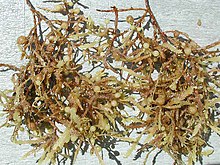

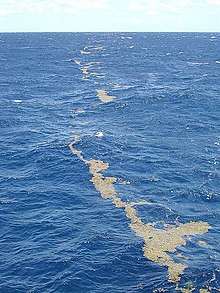

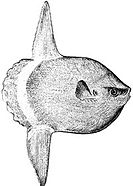


![The Antarctic toothfish have large, upward looking eyes, adapted to detecting the silhouettes of prey fish.[27]](http://upload.wikimedia.org/wikipedia/commons/thumb/9/9d/Dmawsoni_Head_shot.jpg/200px-Dmawsoni_Head_shot.jpg)
![The Barreleye has barrel-shaped, tubular eyes that generally are directed upward, but may be swivelled forward.[28]](http://upload.wikimedia.org/wikipedia/commons/thumb/c/c0/Opisthoproctus_soleatus.png/200px-Opisthoproctus_soleatus.png)
![The stoplight loosejaw has a lower jaw one-quarter as long as its body. The jaw has no floor and is attached only by a hinge and a modified tongue bone. Large fang-like teeth in the front are followed by many small barbed teeth.[29][30]](http://upload.wikimedia.org/wikipedia/commons/thumb/c/c7/Malacosteus_niger.jpg/200px-Malacosteus_niger.jpg)
![The stoplight loosejaw is also one of the few fishes that produce red bioluminescence. As most of their prey cannot perceive red light, this allows it to hunt with an essentially invisible beam of light.[29]](http://upload.wikimedia.org/wikipedia/commons/thumb/b/b2/Malacosteus.JPG/200px-Malacosteus.JPG)
![Longnose lancetfish. Lancetfish are ambush predators that frequent the mesopelagic. They are among the largest mesopelagic fishes (up to 2 metres).[37]](http://upload.wikimedia.org/wikipedia/commons/thumb/0/0d/Longnoselancetfish.jpg/187px-Longnoselancetfish.jpg)
![The daggertooth slashes other mesopelagic fish when it bites them with its dagger-like teeth.[39]](http://upload.wikimedia.org/wikipedia/commons/thumb/3/3a/Daggertooth.PNG/187px-Daggertooth.PNG)

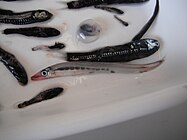

![The black swallower, with its distensible stomach, is notable for its ability to swallow whole bony fishes ten times its mass.[50][51]](http://upload.wikimedia.org/wikipedia/commons/thumb/1/1b/Chiasmodon_niger.jpg/187px-Chiasmodon_niger.jpg)
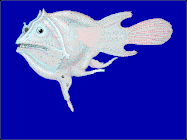
![The widespread fangtooth has the largest teeth of any fish, proportionate to body size.[52] Despite their ferocious appearance, bathypelagic fish are usually weakly muscled and too small to represent any threat to humans.](http://upload.wikimedia.org/wikipedia/commons/thumb/a/a4/Anoplogaster_cornuta_2.jpg/187px-Anoplogaster_cornuta_2.jpg)
![The Sloane's viperfish can make nightly migrations from bathypelagic depths to near surface waters.[53]](http://upload.wikimedia.org/wikipedia/commons/thumb/8/87/Messina_Straits_Chauliodus_sloani.jpg/187px-Messina_Straits_Chauliodus_sloani.jpg)

![The tripodfish (Bathypterois grallator), a species of spiderfish, uses its fin extensions to "stand" on the bottom.[65]](http://upload.wikimedia.org/wikipedia/commons/thumb/7/79/Bathypterois_grallator.jpg/200px-Bathypterois_grallator.jpg)
![The blotched fantail ray feeds on bottom-dwelling fish, bivalves, crabs, and shrimps.[66]](http://upload.wikimedia.org/wikipedia/commons/thumb/6/68/Taeniura_meyeni_reef.jpg/200px-Taeniura_meyeni_reef.jpg)









